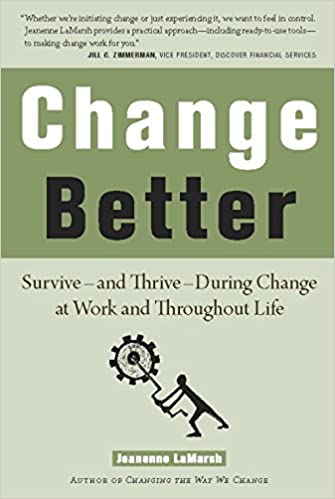Change Better: Survive – and Thrive – During Change at Work and Throughout Life

A surprising amount has been written about change. It’s been written from an organizational context, a personal context, and a societal context. The underlying connection is that all change is personal change. To get our organizations and societies to change, we must change personally as well. This lies at the heart of Jeanenne LaMarsh’s book, Change Better: Survive – and Thrive – During Change at Work and Throughout Life.
Life is Change
The book was written in 2010 – a decade ago. However, the language could be appropriate today even without LaMarsh understanding the scope of her statements. “No matter who you are, the skill to deal with constant change needs to become a permanent part of your life.” The change velocity then was more than it had ever been in the history of human civilization, and it’s even faster now. Instead of measuring change in generations, we measure change in decades, years, months – and even minutes.
Each of us craves stability and certainty. It makes our prediction-engine brains comfortable to know that they can do their jobs. However, we never had certainty. There were changing weather patterns before we could predict the weather. There were floods and fires that would wipe out entire towns. Despite the knowledge that certainty is an illusion, we cling on to it.
To thrive today, we’ve got to let go of the quaint belief that we can know everything or plan for everything, and instead we must build a capacity within ourselves to accept – and even welcome – change. We need to learn how to surf the waves of change instead of being crushed by their relentless nature.
The Transition Delta
What William Bridges calls the neutral zone (see Managing Transitions), LaMarsh calls the delta zone. The Greek letter delta is used to signify change. It’s a place of confusion where every decision that might have previously been automatic must be reevaluated and considered in the context of the new world that we live in. Daniel Kahneman in Thinking, Fast and Slow provided a model for cognition that includes two systems. Most of the time, he explains, we walk around using “System 1,” which is automatic. Switching into “System 2” requires more energy and therefore is a less desirable state. However, in conscious change, we must constantly reengage “System 2” and therefore consume more energy even if the energy is consumed through thinking rather than action.
Thinking Is Not Doing
While it’s true that thinking about something doesn’t make it so, it’s equally true that thinking can be work. In the United States, we have a bias against thinking being “real” work. We can look at the biology and neurology that indicate we’re consuming energy, but somehow, to the protestant work ethic, thinking doesn’t feel like getting anything done.
Of course, we can take Benjamin Franklin’s admonishment, “If you fail to plan, you are planning fail,” as an indication that we must do some planning work to be successful, but that doesn’t make it “feel” more like work. Athletes are taught to visualize their success to enhance their performance. We know that all but the motor neurons fire when someone is visualizing their performance – so they’re rehearsing it. Even patients with amputated arms are taught to visualize to allow them to help them cope with the loss of their limb. (See Descartes’ Error.)
We must fight our bias towards action and moderate our action with our capacity to plan. If we can’t do planning in conjunction with our action, we’re destined to fail.
All Change is Personal
Change Better is squarely focused on the personal level of change. Not that it’s about changing yourself personally but rather it’s about connecting what you need to change personally to help the organization’s change be successful. It’s filled with worksheets of questions that are designed to improve your ability to see the reasons for the need to change, the exact nature of what the change will look like for you personally, and the path to reach this new place.
These worksheets are available from the LaMarsh web site at https://insights.lamarsh.com/personal-change-management-workbook. I’d encourage you to check them out to learn how to Change Better.
